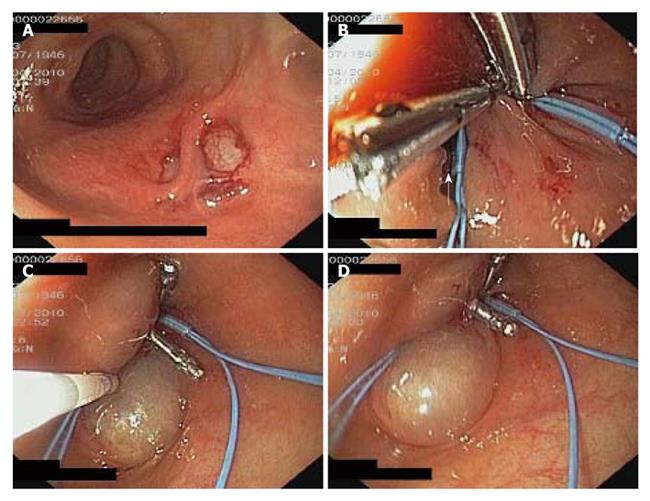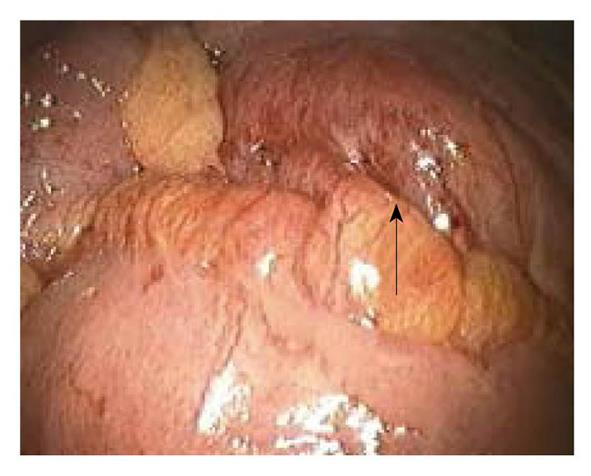Published online Feb 28, 2011. doi: 10.3748/wjg.v17.i8.1088
Revised: November 11, 2010
Accepted: November 18, 2010
Published online: February 28, 2011
We report a case of a 63-year-old male who experienced an iatrogenic sigmoid perforation repaired combining three endoscopic techniques. The lesion was large and irregular with three discrete perforations, therefore, we decided to close it by placing one clip per perforation, and then connecting all the clips with two endoloops. Finally we chose to use a fibrin glue injection to obtain a complete sealing. Four days after the colonoscopy the patient underwent a laparoscopic right hemicolectomy due to evidence of a large polyp of the caecum with high grade dysplasia and focal carcinoma in situ. Inspection of the sigma showed complete repair of the perforation. This report underlines how a conservative approach, together with a combination of various endoscopic techniques, can resolve complicated iatrogenic perforations of the colon.
- Citation: Mocciaro F, Curcio G, Tarantino I, Barresi L, Spada M, Petri SL, Traina M. Tulip bundle technique and fibrin glue injection: Unusual treatment of colonic perforation. World J Gastroenterol 2011; 17(8): 1088-1090
- URL: https://www.wjgnet.com/1007-9327/full/v17/i8/1088.htm
- DOI: https://dx.doi.org/10.3748/wjg.v17.i8.1088
Colonoscopy is considered a safe procedure, although complications can occur. The most dreaded of these is iatrogenic perforation. The literature reports perforation rates of 0.03%-0.8% for diagnostic procedures, and a rate of 0.15%-3% for therapeutic procedures[1]. Mechanisms of perforation are the result of either mechanical disruption of the colonic wall (e.g. thermal injury, forced push into a diverticulum, or stretching of the bowel with loops or the slide-by technique) or excessive air insufflation[1]. After perforation, prompt abdominal surgery is usually recommended, particularly in the last few years, following the introduction of laparoscopic approaches in clinical practice[2,3]. Nevertheless, conservative treatment is a feasible and effective option for patients who are clinically stable and without peritonism or life threatening signs. We describe a case of a sigmoid perforation repaired with endoclips and endoloops, and sealed with fibrin glue. The effectiveness of this approach was confirmed on laparoscopic examination.
A 63-year-old male with a history of polypectomy for a large polyp of the caecum was admitted to our department for a scheduled colonoscopy. Physical examination, blood chemistry and coagulation tests were normal. After obtaining informed consent, the colonoscopy was performed under conscious sedation (propofol). The colon was quite clean, and the colonoscopy proceeded without difficulty, lasting 15 min. Caecum examination, at the same site of the previous polypectomy, showed a large sessile polyp (4 cm in diameter), which was biopsied. No other polyps were detected, although in the sigma, in an environment of diverticula and hyperaemic mucosa, a large and irregular lesion (2.5 cm with 3 discrete perforations) was observed (Figure 1A). The patient’s blood pressure, heart rate and O2 saturation were normal. Due to the form of the lesion, we believed that repair with endoclips alone would have been ineffective, so we decided to close it by placing through-the-scope endoclips over each perforation of the lesion (one clip per perforation), and then connecting all the clips with two endoloops (Figure 1B). Each endoloop was tightened slightly and the endoclips were anchored together securely. However, at the base, two borders of the perforation did not fit well (Figure 1B, arrow), so we chose to use a fibrin glue (Beriplast P®), injected into the submucosa, and obtained complete sealing (Figure 1C and D). Four days after the colonoscopy, the patient underwent a laparoscopic right hemicolectomy due to evidence of high grade dysplasia with focal carcinoma in situ, revealed by biopsies of the polyp. Inspection of the sigma showed complete repair of the perforation (Figure 2, arrow). The patient was able to resume oral diet 4 d later and was discharged 7 d later.
Colonoscopy has played an increasingly important role as a diagnostic, therapeutic, and screening tool[4]. It is safe, with a low rate of perforation (a post-procedure incidence of 0.082% at 7 d in a population-based study of 277 434 colonoscopies[5]). Risk factors are increasing age, significant comorbidities, obstruction as an indication for colonoscopy, diverticulosis, and invasive interventions during colonoscopy[3]. Despite the fact that laparoscopic resection is effective in resolving colonic perforation caused by colonoscopy[2], recent improvements in endoscopic techniques have made it possible to close iatrogenic colonic perforations using mini-invasive procedures. Repair with endoclips has been well described in the literature since 1997[6-8]. Furthermore, large or difficult intestinal perforations can be treated with a combined placement of endoclips and endoloops, as recently reported by Nakagawa et al[9] There is little documentation of the use of fibrin sealant for repairing perforations[10], however, some reports suggest that endoclip placement with fibrin glue sealing is effective in repairing benign lesions, such as fistulas[11]. In our patient, conservative treatment of the colonic perforation was quite difficult because of both the size and shape of the lesion. An approach using only endoclips may have proved to be ineffective, but endoloop placement made it possible to anchor the clips together. Unfortunately, when closed with the endoloops, the star-like points of the lesion did not fully close the perforation, so we decided to seal the base of the perforation with a submucosal injection of fibrin glue. This conservative approach resulted in full closure of the lesion, as subsequently confirmed by laparoscopic examination.
This report underlines how a conservative approach, together with a combination of various endoscopic techniques, can resolve complicated perforations without the need for surgical intervention.
Peer reviewer: AM El-Tawil, MSc, MRCS, PhD, Department of Surgery, University Hospital of Birmingham, East Corridor, Ground Floor, Birmingham, B15 2TH, United Kingdom
S- Editor Sun H L- Editor Webster JR E- Editor Lin YP
| 1. | Panteris V, Haringsma J, Kuipers EJ. Colonoscopy perforation rate, mechanisms and outcome: from diagnostic to therapeutic colonoscopy. Endoscopy. 2009;41:941-951. |
| 2. | Alfonso-Ballester R, Lo Pez-Mozos F, Mart-Obiol R, Garcia-Botello SA, Lledo-Matoses S. Laparoscopic treatment of endoscopic sigmoid colon perforation: a case report and literature review. Surg Laparosc Endosc Percutan Tech. 2006;16:44-46. |
| 3. | Rotholtz NA, Laporte M, Lencinas S, Bun M, Canelas A, Mezzadri N. Laparoscopic approach to colonic perforation due to colonoscopy. World J Surg. 2010;34:1949-1953. |
| 4. | Winawer S, Fletcher R, Rex D, Bond J, Burt R, Ferrucci J, Ganiats T, Levin T, Woolf S, Johnson D. Colorectal cancer screening and surveillance: clinical guidelines and rationale-Update based on new evidence. Gastroenterology. 2003;124:544-560. |
| 5. | Arora G, Mannalithara A, Singh G, Gerson LB, Triadafilopoulos G. Risk of perforation from a colonoscopy in adults: a large population-based study. Gastrointest Endosc. 2009;69:654-664. |
| 6. | Yoshikane H, Hidano H, Sakakibara A, Ayakawa T, Mori S, Kawashima H, Goto H, Niwa Y. Endoscopic repair by clipping of iatrogenic colonic perforation. Gastrointest Endosc. 1997;46:464-466. |
| 7. | Bechtold ML, Hammad HT, Arif M, Choudhary A, Puli SR, Antillon MR. Perforation upon retroflexion: an endoscopic complication and repair. Endoscopy. 2009;41 Suppl 2:E155-E156. |
| 8. | Trecca A, Gaj F, Gagliardi G. Our experience with endoscopic repair of large colonoscopic perforations and review of the literature. Tech Coloproctol. 2008;12:315-321; discussion 322. |
| 9. | Nakagawa Y, Nagai T, Soma W, Okawara H, Nakashima H, Tasaki T, Hisamatu A, Hashinaga M, Murakami K, Fujioka T. Endoscopic closure of a large ERCP-related lateral duodenal perforation by using endoloops and endoclips. Gastrointest Endosc. 2010;72:216-217. |
| 10. | Spotnitz WD. Fibrin sealant: past, present, and future: a brief review. World J Surg. 2010;34:632-634. |










